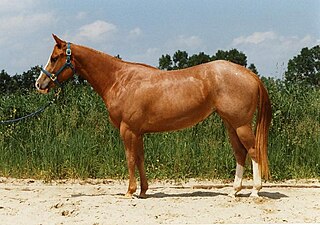
The American Quarter Horse, or Quarter Horse, is an American breed of horse that excels at sprinting short distances. Its name is derived from its ability to outrun other horse breeds in races of 1⁄4 mi (0.40 km) or less; some have been clocked at speeds up to 44 mph (71 km/h). The development of the Quarter Horse traces to the 1600s.

The American Saddlebred is a horse breed from the United States. This breed is referred to as the "Horse America Made". Descended from riding-type horses bred at the time of the American Revolution, the American Saddlebred includes the Narragansett Pacer, Canadian Pacer, Morgan and Thoroughbred among its ancestors. Developed into its modern type in Kentucky, it was once known as the "Kentucky Saddler" and used extensively as an officer's mount in the American Civil War. In 1891, a breed registry was formed in the United States. Throughout the 20th century, the breed's popularity continued to grow in the United States, and exports began to South Africa and Great Britain. Since the formation of the US registry, almost 250,000 American Saddlebreds have been registered and can now be found around the world, with separate breed registries established in Great Britain, Australia, continental Europe, and southern Africa.

The Tennessee Walking Horse or Tennessee Walker is a breed of gaited horse known for its unique four-beat running-walk and flashy movement. It was originally developed as a riding horse on farms and plantations in the American South. It is a popular riding horse due to its calm disposition, smooth gaits and sure-footedness. The Tennessee Walking Horse is often seen in the show ring, but is also popular as a pleasure and trail riding horse using both English and Western equipment. Tennessee Walkers are also seen in movies, television, and other entertainment.

The Azteca is a horse breed from Mexico, with a subtype, called the "American Azteca", found in the United States. They are well-muscled horses that may be of any solid color, and the American Azteca may also have Pinto coloration. Aztecas are known to compete in many western riding and some English riding disciplines. The Mexican registry for the original Azteca and the United States registries for the American Azteca have registration rules that vary in several key aspects, including ancestral bloodlines and requirements for physical inspections. The Azteca was first developed in Mexico in 1972, from a blend of Andalusian, American Quarter Horse and Mexican Criollo bloodlines. From there, they spread to the United States, where American Paint Horse blood was added.
The Racking Horse is a horse breed derived from the Tennessee Walking Horse, recognized by the USDA in 1971. It is known for a distinctive singlefoot gait. In 1971, the Racking Horse Breeders' Association of America, headquartered in Decatur, Alabama, was formed as the breed registry. Its goal is to preserve the breed in a natural state with little or no artificial devices that enhance gait. The horse's tail is naturally raised without nicking or tail sets. Some classes allow special shoes that enhance action, and a relatively newer class allows the use of chains, six ounces and under as action devices. The practice of soring, illegal under the Horse Protection Act of 1970, is also seen within the Racking Horse world. Since the breed's inception, about 80,000 Racking Horses have been registered, with the largest populations located in the US states of Alabama and Tennessee.
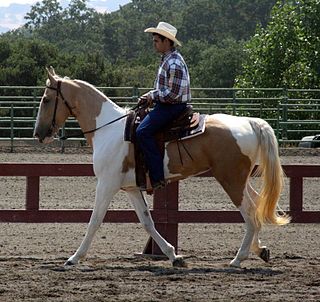
The Spotted Saddle Horse is a horse breed from the United States that was developed by crossing Spanish-American type gaited pinto ponies with gaited horse breeds, such as the Tennessee Walking Horse. The result was a colorful, smooth-gaited horse, used in the show ring and for pleasure and trail riding. Two registries have been created for the breed, one in 1979 and the other in 1985. The two have similar registration requirements, although one has an open stud book and the other is slightly more strict with regard to parentage requirements, having a semi-closed stud book. The Spotted Saddle Horse is a light riding horse, always pinto in color. Solid-colored foals from registered parents may be registered for identification purposes, so their pinto-colored foals have documented parentage. They always perform an ambling gait, rather than a trot, in addition to the gaits of walk and canter, performed by all breeds.

Black Allan or Allan F-1 was the foundation sire of the Tennessee Walking Horse. He was out of a Morgan and Thoroughbred cross mare named Maggie Marshall, a descendant of Figure and the Thoroughbred racing stallion Messenger; and sired by Allandorf, a Standardbred stallion descended from Hambletonian 10, also of the Messenger line.
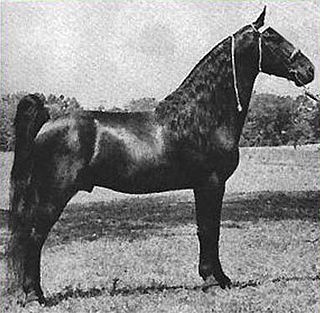
Midnight Sun (1940–65) was one of the leading sires of the Tennessee Walking Horse breed, and a two-time World Grand Champion in 1945 and 1946. He was trained by Fred Walker and lived almost all his life at Harlinsdale Farm in Franklin, Tennessee.
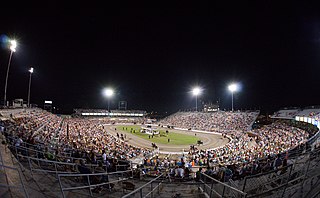
The Tennessee Walking Horse National Celebration (TWHNC), sometimes known as the Celebration, is the largest horse show for the Tennessee Walking Horse breed, and has been held annually in or near Shelbyville, Tennessee since its inception in 1939. The Celebration was conceived by Henry Davis, a horse trainer who along with several other horsemen, felt the Shelbyville area should have a festival or annual event. Although the Celebration was originally held in Wartrace, Tennessee, it moved to Shelbyville, the seat of Bedford County, a few years later. The Celebration spans 11 days and nights in late August and early September annually, and finishes with the crowning of the World Grand Champion Tennessee Walker on the Saturday night before Labor Day. The TWHNC draws an estimated 2,000 horses and 250,000 spectators to Shelbyville each year.
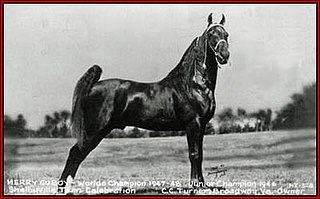
Merry Go Boy was a highly influential Tennessee Walking Horse sire and two-time World Grand Champion. He is credited for producing the most desirable conformation type in his offspring.
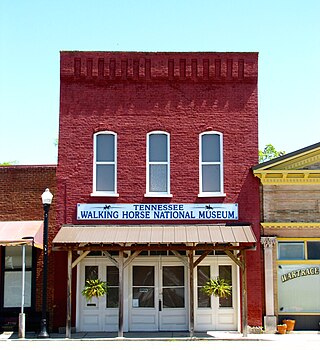
The Tennessee Walking Horse National Museum is the only museum dedicated entirely to the Tennessee Walking Horse. It is located in downtown Wartrace, Tennessee, and contains exhibits on all aspects of the Walking Horse industry.

Merry Legs (1911–1932) was a Tennessee Walking Horse mare who was given foundation registration for her influence as a broodmare. She was also a successful show horse.
Albert Dement was an American early Tennessee Walking Horse breeder.
The Racking Horse Breeders' Association of America (RHBAA) is the original registry for the Racking Horse breed. It was formed in 1971 in Decatur, Alabama and is still located there.
The Spotted Saddle Horse Breeders' and Exhibitors' Association (SSHBEA) is an equestrian organization for the registration and promotion of the Spotted Saddle Horse breed. The SSHBEA is headquartered in Shelbyville, Tennessee.
Elizabeth Fay Sain, is a former Tennessee Walking Horse trainer and breeder from Tennessee. In 1966 she became the first woman to win the breed's World Grand Championship with the horse Shaker's Shocker.
Shaker's Shocker was a Tennessee Walking Horse stallion who won his breed's World Grand Championship in 1966.

Billie Nipper was an American artist who specialized in painting portraits of horses. Nipper, a native of Cleveland, Tennessee, painted every horse that won the Tennessee Walking Horse World Grand Championship from 1976 until her death. Besides Tennessee Walking Horses, she painted other breeds of horse, as well as landscapes. Her paintings were made into prints and transferred onto china and other objects. Nipper also bred horses, and her husband and son were horse trainers.
Charles Emmett Brantley was a Tennessee Walking Horse breeder. He grew up on a farm in Coffee County, Tennessee and competed in the first Tennessee Walking Horse National Celebration. Besides breeding horses, he was a horse trainer for several years, but quit riding due to health issues. He was married to his wife Nellie for 70 years, and was inducted into both the Tennessee Walking Horse Hall of Fame and the Tennessee Sports Hall of Fame.

The horse industry in Tennessee is the 6th largest in the United States, and over 3 million acres of Tennessee farmland are used for horse-related activities. The most popular breed in the state is the Tennessee Walking Horse - developed by crossing Thoroughbred, Morgan, Saddlebred, and Standardbred horses in the 19th and 20th centuries - and it became an official state symbol in 2000.













